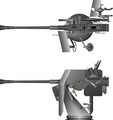German submarine U-249
 U-249 after the surrender of Nazi Germany
| |
| History | |
|---|---|
| Name | U-249 |
| Ordered | 5 June 1941 |
| Builder | Germaniawerft, Kiel |
| Yard number | 683 |
| Laid down | 23 January 1943 |
| Launched | 23 October 1943 |
| Commissioned | 20 November 1943 |
| Fate |
|
| General characteristics | |
| Class and type | Type VIIC submarine |
| Displacement | |
| Length |
|
| Beam |
|
| Height | 9.60 m (31 ft 6 in) |
| Draught | 4.74 m (15 ft 7 in) |
| Installed power |
|
| Propulsion |
|
| Speed |
|
| Range | |
| Test depth |
|
| Complement | 4 officers, 40–56 enlisted |
| Armament |
|
| Service record[1] | |
| Part of: |
|
| Identification codes: | M 54 401 |
| Commanders: |
|
| Operations: |
|
| Victories: | None |
German submarine U-249 was a
In two patrols, she sank no ships.
She surrendered on 10 May 1945 and was sunk on 13 December as part of Operation Deadlight.
Design
The submarine had a maximum surface speed of 17.7 knots (32.8 km/h; 20.4 mph) and a maximum submerged speed of 7.6 knots (14.1 km/h; 8.7 mph).
Armament
FLAK weaponry
U-249 was mounted with a single
-
The single 3.7 cm Flak M42U gun on the LM 43U mount.
-
2 cm Flak C38 in a M 43U Zwilling mount with short folding shield.
Service history
After training with the 5th U-boat Flotilla at Kiel, U-249 remained with that organization for front-line service from 1 January 1945.
First patrol
The boat's first patrol was preceded by a pair of short trips between Kiel in Germany, and Kristiansand and Bergen in Norway. Her first sortie proper started with her departure from Bergen on 7 March 1945. It finished in the same port on 16 March. While sailing on another non-classifiable voyage, she shot a Mosquito of No. 235 Squadron RAF down. The pilot was captured.
Second patrol and surrender
She left Bergen on 3 April 1945[4] and arrived at Portland, UK, flying the black flag of surrender on 10 May.[5]
She was then briefly used by the British as the research ship N 86 before being transferred to Loch Ryan in Scotland for Operation Deadlight. She was sunk on 13 December 1945.[1]
In May 2013 her official
References
- ^ a b c Helgason, Guðmundur. "The Type VIIC boat U-249". German U-boats of WWII – uboat.net. Retrieved 30 July 2012.
- ^ a b c d Gröner 1991, pp. 43–46.
- ^ Base on war-time photographs.
- ^ Helgason, Guðmundur. "War Patrols by German U-boat U-249". German U-boats of WWII – uboat.net. Retrieved 30 December 2014.
- ^ a b "Chepstow Racecourse 1". Antiques Roadshow. Series 35. Episode 22. 5 May 2013. BBC. Retrieved 5 May 2013.
Bibliography
- Busch, Rainer; Röll, Hans-Joachim (1999). German U-boat commanders of World War II : a biographical dictionary. Translated by Brooks, Geoffrey. London, Annapolis, Md: Greenhill Books, Naval Institute Press. ISBN 1-55750-186-6.
- Busch, Rainer; Röll, Hans-Joachim (1999). Deutsche U-Boot-Verluste von September 1939 bis Mai 1945 [German U-boat losses from September 1939 to May 1945]. Der U-Boot-Krieg (in German). Vol. IV. Hamburg, Berlin, Bonn: Mittler. ISBN 3-8132-0514-2.
- Gröner, Erich; Jung, Dieter; Maass, Martin (1991). U-boats and Mine Warfare Vessels. German Warships 1815–1945. Vol. 2. Translated by Thomas, Keith; Magowan, Rachel. London: Conway Maritime Press. ISBN 0-85177-593-4.
External links
- Helgason, Guðmundur. "The Type VIIC boat U-249". German U-boats of WWII – uboat.net. Retrieved 26 December 2014.
- Hofmann, Markus. "U 249". Deutsche U-Boote 1935-1945 – u-boot-archiv.de (in German). Retrieved 26 December 2014.


